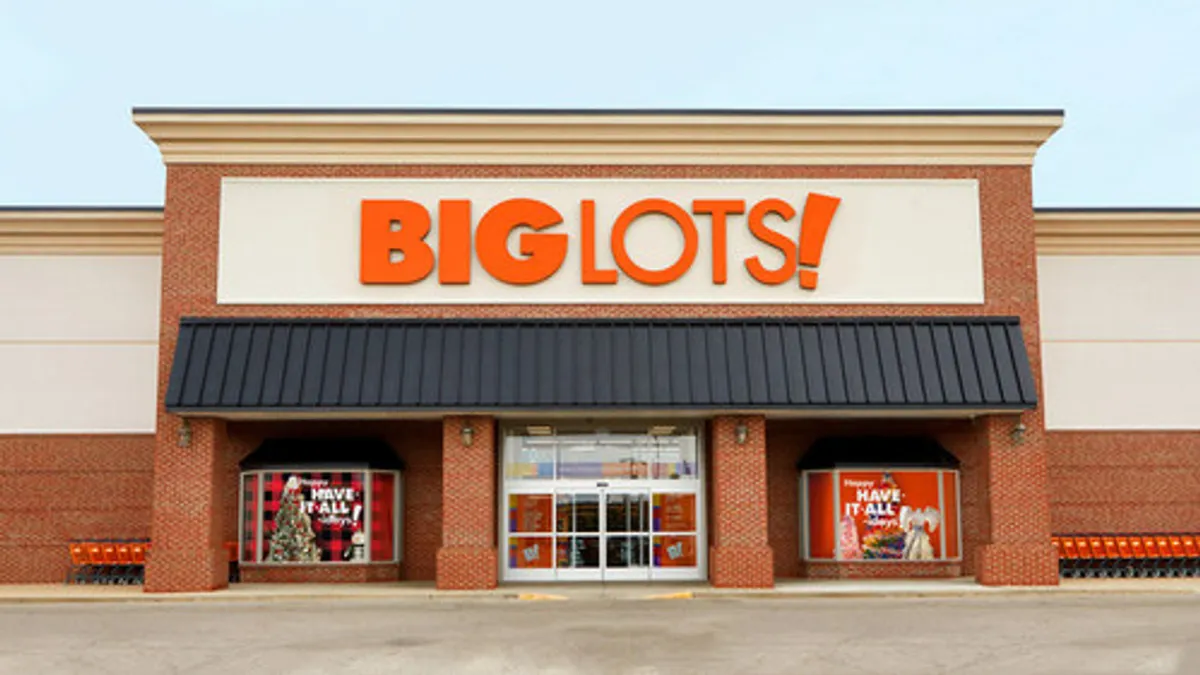Dive Brief:
- Big Lots’ first-quarter net sales fell 10.2% to $1 billion, down from $1.1 billion last year, the retailer said Thursday. The company also posted a net loss of $205 million, relatively flat from the prior year, though CEO Bruce Thorn said Big Lots’ net liquidity grew to $289 million, up from $254 million in Q4, thanks to cost-management initiatives.
- Debt also rose to $573.8 million during the quarter, up from $501.6 million a year ago. Comparable sales fell nearly 10% year over year, while gross margin was up slightly to 36.8%.
- Although Big Lots has made progress on improving its business operations, Thorn said the company continues to feel the effects of constrained consumer spending on big-ticket discretionary items, thanks in part to inflation and high interest rates.
Dive Insight:
Thorn said during a Thursday earnings call that it identified an opportunity to move faster on its Project Springboard cost-cutting initiative. As a result, Thorn said the company is raising its target savings goal to $185 million by year end, up from $175 million.
Big Lots ended the first quarter with lower inventory — down to $949.9 million from about $1.09 billion last year. The company said lower on-hand units and average unit costs helped drive that metric down. The company continues to focus on securing more extreme bargain merchandise and made a series of changes to its merchandising team in March to improve its acquisition efforts.
“With a highly focused extreme value merchant team that will continue to flex our open-to-buy, we are quickly expanding our relationship with vendors with a bigger seat at the closeout table,” Thorn said.
The executive expects positive comps toward the end of the year and gross margin improvement over time. Still, Neil Saunders, managing director of GlobalData, called Big Lots’ performance “one of the worst in the retail sector,” noting that the 10.2% decline in sales follows poor performance last year that leaves the retailer deep in the red.
“While management blames most of the decline on softness among consumers, this doesn’t stack up against what other retailers are reporting — especially in the off-price sector where results are very positive,” Saunders said in emailed comments to Retail Dive. “As such, most of this is on Big Lots. The proposition is not compelling or interesting enough to draw in consumers and make them spend. Big Lots is trying to introduce more bargains, but this does not seem to be working.”
However, analysts with Telsey Advisory Group led by Joe Feldman said Big Lots is due some credit for gaining momentum in its ongoing turnaround strategy.
“We believe Big Lots is in a tough spot, with its core lower to middle income consumer under incremental financial pressure and avoiding spending on discretionary products, which is central to its assortment,” Feldman said Monday in an earnings preview note. “That said, the challenging macro backdrop is masking some of Big Lots' progress on its transformation strategy — merchandising, digital, loyalty, optimization of margins, and enhancement of the supply chain infrastructure.”
Big Lots has taken several steps over the last year to improve its financial position and operational performance. Last year, it leased back most of its owned stores, a California distribution center and its corporate headquarters building in Ohio. In April, the company took out a new $200 million first-in, last-out term loan to further improve its liquidity. That loan is secured by a mortgage on the corporate headquarters and is in addition to an existing $900 million asset-based loan.
Also in April, Big Lots opened buying offices in China and Vietnam. The company said the move will enhance merchandise sourcing competitiveness and reduce costs by bringing the operation in house. Big Lots’ second quarter outlook is for comp sales to improve sequentially relative to Q1 and to be down in the mid- to high-single-digit range, as actions to improve the business continue gaining traction.














